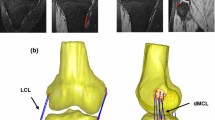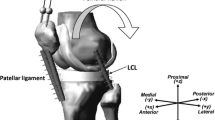Abstract
Background
Proper alignment and balancing of soft tissues of the knee are important goals for TKA. Despite standardized techniques, there is no consensus regarding the optimum amount of collateral ligament laxity one should leave at the end of the TKA.
Questions/purposes
I asked (1) what is the collateral laxity in young healthy volunteers, and (2) is there a difference in collateral laxity between males and females.
Methods
The femorotibial mechanical angle (FTMA) was measured in 314 knees in healthy volunteers aged 19 to 35 years. Subjects with a history of pain, malalignment, dysplasia, or trauma were excluded. Twenty-five knees were excluded because the hip center could not be acquired, and 22 were excluded because of a history of pain and trauma, leaving 267 knees for inclusion in the study. Of these, 155 were from men and 112 were from women. A validated method using a computer navigation system was used to obtain the measurements. A 10-Nm torque was used to stress the knee in varus and valgus at 0° extension and 15° flexion. An independent t-test and ANOVA were applied to the data to calculate any significant difference between groups (p < 0.05).
Results
The mean (SD) unstressed supine FTMA was varus of 1.2° (SD, 4°) in 0° extension and varus of 1.2° (SD, 4.4°) in 15° flexion (p = 0.88). On varus torque of 10 Nm, the supine FTMA changed by a mean of 3.1° (SD, 2°) (95% CI, 2.4°–3.8°; p < 0.001) in 0° extension and 6.9° (SD, 2.6°) (95% CI, 6.2°–7.7°; p < 0.001) in 15° flexion. On valgus torque of 10 Nm, the FTMA changed by a mean of 4.6° (SD, 2.2°) (95% CI, 3.9°–5.3°; p < 0.001) in 0° extension and 7.9° (SD, 3.4°) (95% CI, 7.1°–8.7°; p < 0.001) in 15° flexion. The mean unstressed FTMA in 0° extension was varus of 1.7° (SD, 4°) in men and 0.4° (SD, 3.9°) in women (p = 0.01). Differences in collateral ligament laxity were seen between men and women (p < 0.001 for valgus torque and 0.035 for varus torque in 15° flexion). With valgus torque at 0° flexion, the supine FTMA change was valgus of 4.2° (SD, 2.0°) for men and 5.0° (SD, 2.4°) for women, while at 15° flexion the FTMA change was valgus 7.6° (SD, 3.6°) for men and 8.3° (SD, 3.2°) for women With varus torque at 0° flexion, additional varus was −3.0° (SD, 1.8°) for men and −3.3° (SD, 2.2°) for women, while at 15° flexion, varus was −7.0° SD, (2.5°) for men and −6.9° (SD, 2.8°) for women.
Conclusions
The collateral laxity in young healthy volunteers was quantified in this study. The collateral ligament laxity is variable in different persons. In addition, ligaments in women are more lax than in men in valgus stress.
Clinical Relevance
This study was conducted on young, healthy knees. Whether the findings are applicable to arthritic knees and replaced knees needs additional evaluation. However the findings provide a baseline from which to work in the evaluation of arthritic knees and in the case of TKA.


Similar content being viewed by others
References
Bankes MJ, Back DL, Cannon SR, Briggs TW. The effect of component malalignment on the clinical and the radiological outcome of the Kinemax total knee replacement. Knee. 2003;10:55–60.
Bargren JH, Blaha JD, Freeman MA. Alignment in total knee arthroplasty: correlated biomechanical and clinical observations. Clin Orthop Relat Res. 1983;173:178–183.
Bathis H, Perlick L, Tingart M, Luring C, Zurakowski D, Grifka J. Alignment in total knee arthroplasty: comparison of computer-assisted surgery with the conventional technique. J Bone Joint Surg Br. 2004;86:682–687.
Bellemans J, Colyn W, Vandenneucker H, Victor J. The Chitranjan Ranawat Award: Is neutral mechanical alignment normal for all patients? The concept of constitutional varus. Clin Orthop Relat Res. 2012;470:45–53.
Bourne RB, Chesworth BM, Davis AM, Mahomed NN, Charron KD. Patient satisfaction after total knee arthroplasty: who is satisfied and who is not? Clin Orthop Relat Res. 2010;468:57–63.
Brouwer RW, Jakma TS, Bierma-Zeinstra SM, Ginai AZ, Verhaar JA. The whole leg radiograph: standing versus supine for determining axial alignment. Acta Orthop Scand. 2003;74:565–568.
Chauhan SK, Scott RG, Breidahl W, Beaver RJ. Computer-assisted knee arthroplasty versus a conventional jig-based technique: a randomised, prospective trial. J Bone Joint Surg Br. 2004;86:372–377.
Clarke JV, Riches PE, Picard F, Deakin AH. Non-invasive computer-assisted measurement of knee alignment. Comput Aided Surg. 2012;17:29–39.
Clarke JV, Wilson WT, Wearing SC, Picard F, Riches PE, Deakin AH. Standardising the clinical assessment of coronal knee laxity. Proc Inst Mech Eng H. 2012;226:699–708.
Creaby MW, Wrigley TV, Lim BW, Bowles KA, Metcalf BR, Hinman RS, Bennell KL. Varus-valgus laxity and passive stiffness in medial knee osteoarthritis. Arthritis Care Res (Hoboken). 2010; 62:1237–1243.
Eckhoff DG, Bach JM, Spitzer VM, Reinig KD, Bagur MM, Baldini TH, Flannery NM. Three-dimensional mechanics, kinematics, and morphology of the knee viewed in virtual reality. J Bone Joint Surg Am. 2005;87(suppl 2):71–80.
Harvey WF, Niu J, Zhang Y, McCree PI, Felson DT, Nevitt M, Xu L, Aliabadi P, Hunter DJ. Knee alignment differences between Chinese and Caucasian subjects without osteoarthritis. Ann Rheum Dis. 2008; 67:1524–1528.
Heesterbeek PJ, Verdonschot N, Wymenga AB. In vivo knee laxity in flexion and extension: a radiographic study in 30 older healthy subjects. Knee. 2008;15:45–49.
Hovinga KR, Lerner AL. Anatomic variations between Japanese and Caucasian populations in the healthy young adult knee joint. J Orthop Res. 2009;27:1191–1196.
Howell SM, Kuznik K, Hull ML, Siston RA. Longitudinal shapes of the tibia and femur are unrelated and variable. Clin Orthop Relat Res. 2010;468:1142–1148.
Ishii Y, Matsuda Y, Ishii R, Sakata S, Omori G. Coronal laxity in extension in vivo after total knee arthroplasty. J Orthop Sci. 2003;8:538–542.
Ishii Y, Noguchi H, Matsuda Y, Takeda M, Walker SA, Komistek RD. Effect of knee laxity on in vivo kinematics of meniscal-bearing knee prostheses. Knee. 2007;14:269–274.
Jenny JY, Boeri C. Unicompartmental knee prosthesis: implantation with a non-image-based navigation system. In: DiGioia A, Jaramaz B, Picard F, Nolte LP, eds. Computer and Robotic Assisted Knee and Hip Surgery. New York, NY: Oxford University Press Inc; 2004:181–188.
Markolf KL, Graff-Radford A, Amstutz HC. In vivo stability: a quantitative assessment using an instrumented clinical testing apparatus. J Bone Joint Surg Am. 1978;60:664–674.
Matsuda Y, Ishii Y, Noguchi H, Ishii R. Effect of flexion angle on coronal laxity in patients with mobile-bearing total knee arthroplasty prostheses. J Orthop Sci. 2005;10:37–41.
Nguyen AD, Shultz SJ. Sex differences in clinical measures of lower extremity alignment. J Orthop Sports Phys Ther. 2007; 37:389–398.
Parratte S, Pagnano MW, Trousdale RT, Berry DJ. Effect of mechanical axis alignment on the fifteen-year survival of modern, cemented total knee replacements. J Bone Joint Surg Am. 2010;92:2143–2149.
Ritter MA, Faris PM, Keating EM, Meding JB. Postoperative alignment of total knee replacement: its effect on survival. Clin Orthop Relat Res. 1994;299:153–156.
Russell DF, Deakin AH, Fogg QA, Picard F. Non-invasive, non-radiological quantification of anteroposterior knee joint ligamentous laxity: a study in cadavers. Bone Joint Res. 2013;2:233–237.
Saragaglia D, Picard F, Chaussard C, Montbarbon E, Leitner F, Cinquin P. [Computer-assisted knee arthroplasty: comparison with a conventional procedure. Results of 50 cases in a prospective randomized study] [in French]. Rev Chir Orthop Reparatrice Appar Mot. 2001;87:18–28.
Sharkey PF, Hozack WJ, Rothman RH, Shastri S, Jacoby SM. Insall Award paper: Why are total knee arthroplasties failing today? Clin Orthop Relat Res. 2002;404:7–13.
Shultz SJ, Sander TC, Kirk SC, Perrin DH. Sex differences in knee joint laxity change across the female menstrual cycle. J Sports Med Phys Fitness. 2005;45: 594–603.
Shultz SJ, Schmitz RJ, Beynnon BD. Variation in varus/valgus and internal/external rotational knee laxity and stiffness across the menstrual cycle. J Orthop Res. 2011;29:318–325.
Stulberg DS, Loan P, Sarin V. Computer-assisted navigation in total knee replacement: results of an initial experience in thirty-five patients. J Bone Joint Surg Am. 2002;84(suppl 2):90–98.
van der Esch M, Steultjens MPM, Lems WF, Dekker J. Gender difference in varus–valgus laxity in osteoarthritis of the knee. Scand J Rheumatol. 2007;36:157–159.
Willcox NM, Clarke JV, Smith BR, Deakin AH, Deep K. A comparison of radiological and computer navigation measurements of lower limb coronal alignment before and after total knee replacement. J Bone Joint Surg Br. 2012;94;1234–1240.
Yoo JC, Ahn JH, Sung KS, Wang JH, Lee SH, Bae SW, Ahn YJ. Measurement and comparison of the difference in normal medial and lateral knee joint opening. Knee Surg Sports Traumatol Arthrosc. 2006:14:1238–1244.
Acknowledgments
I thank Avtar Singh MS, S. Babhulakar MS, Dilip Patel MS, N. Vaidya MS, K. K. Eachampati MS, Sunil Aspingi MS, SinFortis Hospital Chandigarh, and the staff at the different centers for making the study feasible at their centers. Thank you also to Frederic Picard FRCS, Jon Clarke FRCS Orth, and Angela Deakin PhD for previous work on the technique and Dr Deakin providing the statistical support. Thank you to Prateek Mann BSc for compiling the data electronically. I also thank all of the volunteers for offering to be measured. I acknowledge logistics support from B Braun Aesculap (B Braun Melsungen AG, Tutlingen, Germany) and its employees Maninder Singh, Francois Leitner, and Uta Giordano for their personal hard work.
Author information
Authors and Affiliations
Corresponding author
Additional information
The author certifies that he, or a member of his or her immediate family, has no funding or commercial associations (eg, consultancies, stock ownership, equity interest, patent/licensing arrangements, etc) that might pose a conflict of interest in connection with the submitted article.
All ICMJE Conflict of Interest Forms for authors and Clinical Orthopaedics and Related Research ® editors and board members are on file with the publication and can be viewed on request.
Clinical Orthopaedics and Related Research ® neither advocates nor endorses the use of any treatment, drug, or device. Readers are encouraged to always seek additional information, including FDA approval status, of any drug or device before clinical use.
The author certifies that his or her institution approved or waived approval for the human protocol for this investigation, that all investigations were conducted in conformity with ethical principles of research, and that informed consent for participation in the study was obtained.
About this article
Cite this article
Deep, K. Collateral Ligament Laxity in Knees: What Is Normal?. Clin Orthop Relat Res 472, 3426–3431 (2014). https://doi.org/10.1007/s11999-014-3865-6
Received:
Accepted:
Published:
Issue Date:
DOI: https://doi.org/10.1007/s11999-014-3865-6




